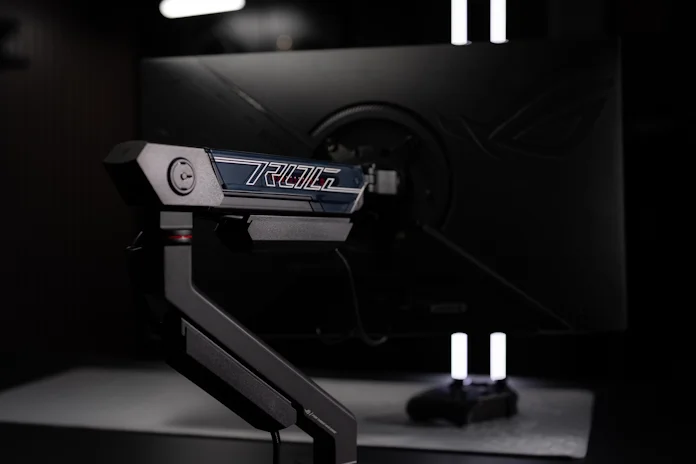Perhaps you know the feeling. You’ve upgraded your graphics card, you’ve got a keyboard with the perfect switches, a mouse that glides like silk, and a monitor that makes your favorite games look unreal. But when you start to set it all up, you realize that there’s nowhere to put it all. Between the monitor stand, the PC, the keyboard, and the rest of your gear, your setup feels like it’s closing in on you. Fortunately, there’s one simple, transformative tool that can unlock a ton of room and flexibility without compromising performance or aesthetics: a monitor arm.
Sound familiar? You’re not alone. For many gamers, especially those in apartments, dorm rooms, or compact home offices, desk space is one of the biggest constraints for their gaming rig. But when you combine a monitor arm with smart desk organization and a few hardware placement strategies, it’s entirely possible to fit a full-blown gaming setup on a smaller desk and make it feel like a command center.
Going small doesn’t have to involve compromise
Not everyone has a wide-open space that they can devote entirely to a PC gaming rig. Gamers who live in apartments or dorm rooms often need to integrate their PC setup into a multipurpose living area. Some folks build their gaming PCs in compact home offices that need to play multiple roles. Other people game with their partner, and need a strategy for fitting two complete setups in close proximity to each other.
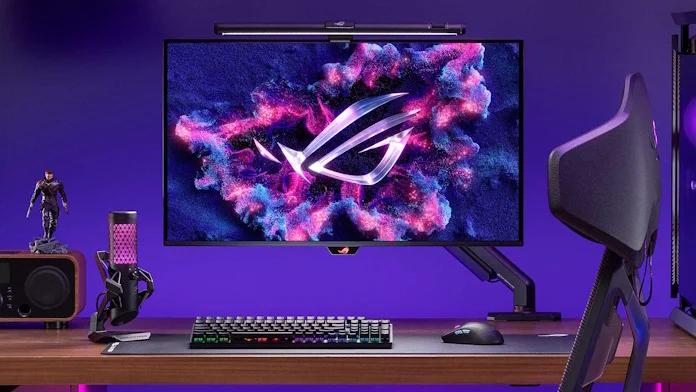
Thankfully, a smaller desk doesn’t have to mean a compromised setup. It just means a more deliberate one. Many gamers assume that to enjoy PC gaming comfortably, you need a massive corner desk or a dedicated battle station with acres of surface area. But efficient use of space can make up for the size of a smaller desk.
Vertical and positional optimization make all the difference when space is at a premium. Think of your gaming setup like a city skyline rather than a flat map. In the same way skyscrapers solve the problem of limited land, a well-placed monitor arm and tidy cable management let you build upward, making every square inch count.
Your monitor stand might be limiting your options
Some gamers do have a large desk, and don’t mind getting a monitor with an extra-large stand. Those wide-ranging V-shaped feet are perfect for holding an extra-large monitor securely in place. But they can take up desk real estate that you need to preserve for a keyboard, mouse, speakers, and other accessories, especially if you’re working with a relatively shallow desk.
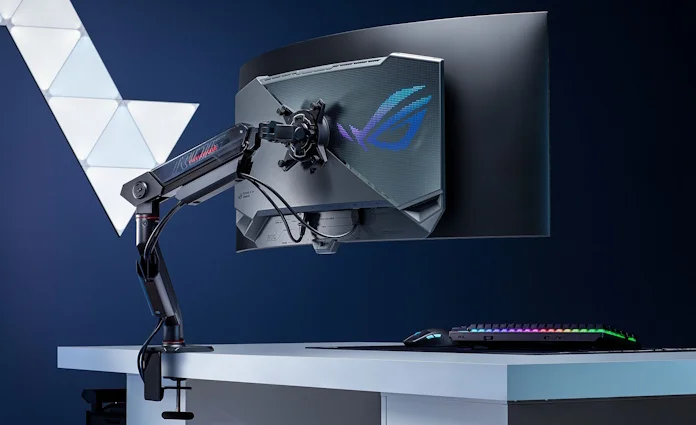
That’s where a monitor arm comes in. It clamps directly to the back or side of your desk and lifts your display into the air, effectively erasing the footprint of that bulky stand. This gives you all that space back for your other gear, accessories, or even just your hands and wrists. It gives you a cleaner overall setup. And it’s a huge ergonomic win too, because your display’s position becomes much more flexible.
Why a monitor arm changes everything
The first thing you notice after installing a monitor arm is how much lighter your whole setup feels. Suddenly, you’re not trapped by the static angle and height of your screen. You can pull it closer during an intense session of DOOM: The Dark Ages, tilt it slightly to reduce glare, or push it back to make space when you’re using a controller. It transforms your monitor from a fixed object into a movable, adaptable part of your workspace.
That flexibility offers bolstered convenience, too. When you can move your screen out of the way, you can rearrange your setup on the fly. Need to plug something into the back of your tower? Swing the display aside. Want to write something by hand or use a drawing tablet? Lift it up and reclaim that central space. This adaptability is what makes a monitor arm such a game-changer for smaller desks. It lets your desk serve multiple functions without feeling cramped or cluttered.
Finding the right monitor arm for your setup
Not all monitor arms are created equal, and choosing the right one matters if you want to maximize both function and style. Start by checking compatibility: your monitor should have a standard VESA mount on the back, typically a 75x75mm or 100x100mm square pattern. Many gaming monitors do, but it’s always worth confirming.
Then, consider the weight capacity. Heavier displays, especially those with ultrawide or curved panels, may require a more robust arm with a higher weight rating. Gas-spring models offer smooth, easy adjustments, allowing you to reposition your monitor with a single hand instead of wrestling with screws or knobs.
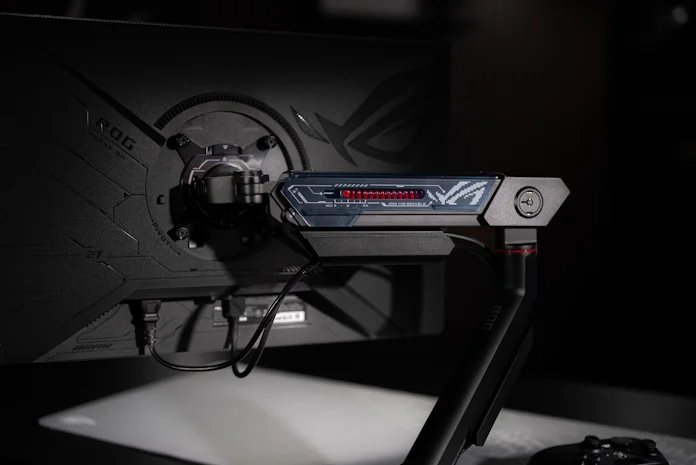
Finally, think about the aesthetic fit. Many modern monitor arms have sleek, minimal designs in matte black or silver finishes that blend seamlessly with gaming setups. Some even include integrated cable routing channels, which help keep your cords neat and out of sight.
Positioning for performance and comfort
People don’t always anticipate how much they’ll love how a monitor arm gives them the freedom to fine-tune their ergonomics. On a small desk, that’s especially valuable, because every inch matters. Ideally, your monitor should sit directly in front of you, with the top of the screen roughly at or just below eye level. The screen should be about an arm’s length away, though you can tweak that depending on your monitor size and field of view preferences for gaming.
Being able to tilt, rotate, and swivel your screen means you can adjust your setup for different scenarios. During competitive gaming sessions, you might want the monitor closer for a more immersive, focused feel. When watching a movie or streaming, you might push it back slightly for a more relaxed viewing angle. These micro-adjustments can reduce neck strain, improve posture, and keep you comfortable over long hours.
Smart storage and peripheral placement
Beyond the display and tower, smaller desks benefit immensely from intentional placement of accessories. Compact keyboards (such as tenkeyless or 75% layouts) can reclaim a surprising amount of room for your mouse hand. If you use a headset, hang it on a simple under-desk hook rather than letting it rest on the surface. External drives or controllers can go in small drawers or side shelves instead of being scattered across the desk.
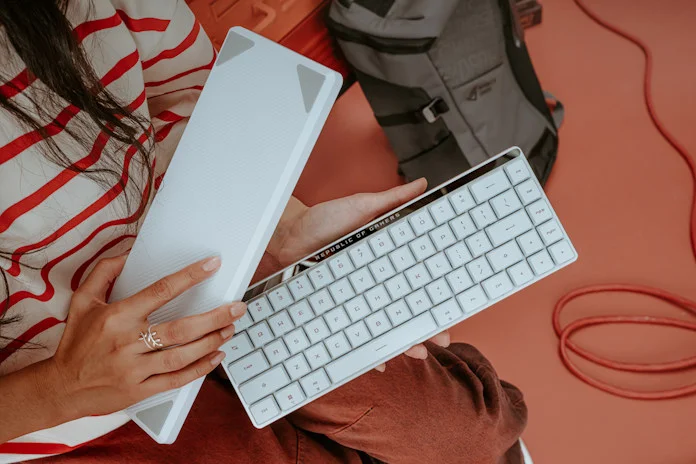
The key is to keep the central workspace open. You want the area in front of your keyboard to feel breathable, with space for your wrists, for quick notes, or just a place to put your drink without bumping into something. Every accessory should have a home, and the monitor arm helps establish the minimalist aesthetic that defines a clean setup.
Lighting, mood, and aesthetics
Once your space is physically optimized, you can focus on the atmosphere. Small desk setups benefit from well-placed lighting, especially bias lighting behind the monitor. A thin LED light strip mounted on the back of your display not only looks great but also reduces eye strain during nighttime gaming sessions. Alternatively, you can get both a desk lamp and bias lighting with the ROG Aura Monitor Light Bar. And since it clamps to the top of monitors, it won’t claim even an inch of desk space.
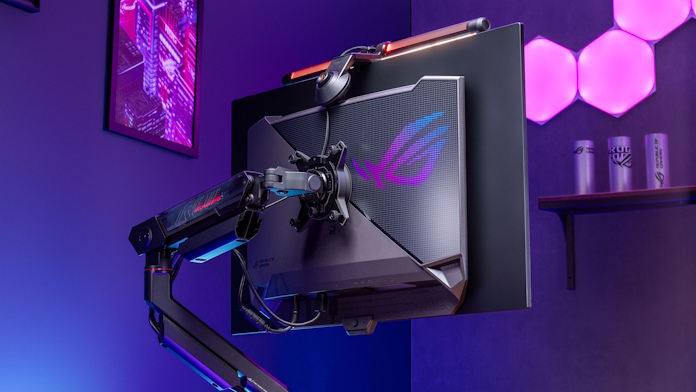
With a monitor arm, you can angle your light sources more effectively. Since your monitor isn’t fixed, you can tweak the lighting to avoid reflections or glare. That means your desk lamp, ring light, or RGB accents can all work in harmony instead of fighting against awkward shadows or hot spots. Your environment will feel intentional rather than improvised.
The psychological impact of space
Don’t underestimate the mental benefits of a tidy, spacious setup. A cluttered desk can subtly increase stress and make gaming feel chaotic rather than relaxing. Conversely, freeing up space creates a sense of calm control.
When your monitor floats above the desk, cables are hidden, and every component feels like it’s in the right place, it changes how you experience the setup. You see a compact, efficient command center. It feels like you’ve unlocked extra room without upgrading furniture. That mindset shift can make even a small corner desk feel comfortable.
A monitor arm brings big potential to small desks
Fitting a full gaming setup onto a smaller doesn’t need to be an adventure in downsizing. Instead, it can be an opportunity to upgrade your layout. The monitor arm acts as the unsung hero in that transformation. By lifting your display off the desk, it frees up valuable surface space, enhances ergonomics, and unlocks a level of flexibility that static setups just can’t match.

For your ROG gaming setup, grab the ROG Ergo Monitor Arm. This sturdy unit can hold any display up to 39 inches and between 3kg and 11.5kg in weight (for flat monitors) or between 3kg and 8.5 kg in weight (for curved monitors). The arm’s double-sided cable management allows you to keep wires tidy while still allowing enough slack for a full range of motion, and the cyberpunk-inspired design matches perfectly with the rest of your ROG gear.

